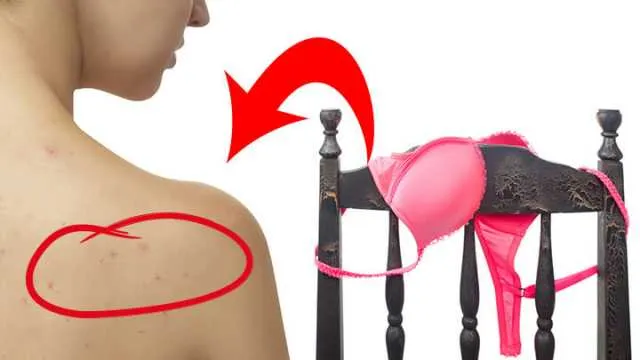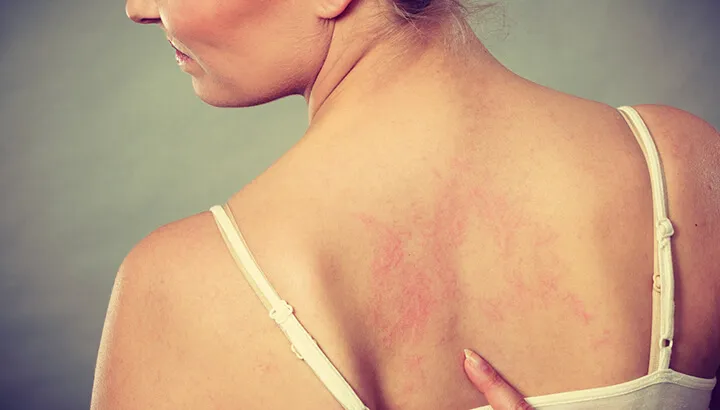
- Share on Facebook382
- Share on Pinterest
- Share on Twitter
While you may be diligent in keeping your clothes clean and have a meticulous hygiene protocol, there may be one thing that you fail to pay close attention to: your bra. Believe it or not, because your bra rests right up against your skin, it should be washed more frequently than you might think.
Mary Begovic Johnson, a senior scientific communications manager of Procter and Gamble, notes that a woman should not wear her bra more than three to five days without washing. Of course, always wash your brassiere by hand or on delicate cycle to avoid wear and tear. Bras that are thrown into your everyday wash tend to lose their form and integrity.
If you are one of those people who does not wash your bra for several weeks, you will definitely want to pay attention to what happens when you continue to wear your bra beyond a week or so:
Gross stuff grows on your bra
There are many things that begin to grow on a dirty bra including bacteria, dirt, lotion, oil, microorganisms, fungi and yeast to name a few. With each passing day, these nasties continue to accumulate. According to Joshua Zeichner, a New York dermatologist, this gross stuff may cause a problem if their growth is left unsupervised.
A rash or infection might develop

WebMD lists clothing in their “Dirty Dozen” of the most common skin irritations. Clothes can become irritating for a number of reasons, including the fact that they don’t fit properly or they’re not washed enough. As bacteria and yeast grow on your dirty bra, they find a nice nesting place under your breasts where they multiply further. This can create the perfect environment for a rash or even infection. Skin can quickly become red, raw and itchy.
Your nipples can become chafed
Chafed nipples are clearly a woman’s worst enemy. It is a painful and highly annoying condition that is difficult to tolerate. The number one cause of chafed nipples is a dirty bra. According to Dr. Robin Travers, a Boston dermatologist, dry skin mixed with a sweaty bra makes for the perfect storm when it comes to chafed nipples. When moisture gets trapped between a dirty bra and your skin, it is a five-alarm fire for your nipples.
You might get an acne breakout
Who wants acne on or under their breasts? That is exactly what can happen when you fail to wash your bra frequently enough, especially if you are exercising in a sports bra. Dirty and sweaty undergarments are the most common trigger for body acne. Obviously, you can avoid this ugly mess if you just keep your bra clean. Bras fit very close to your skin and as the bacteria build up between your breasts and the bra it can cause friction. Acne outbreaks are common in areas where rubbing and excess heat combine. You can easily develop “backne” as well as pimples along your rib cage and under your breasts if you let your bra get too dirty.
You might stink

Bacteria, fungus and yeast mingled together do not create a sweet aroma, that is for sure. Once your bra starts to stink, it is only a matter of time before your clothes start to stink too and your friends are turning their heads because you smell like a gym locker room. This won’t do positive things for your professional or personal life.
You might stain your bra
Although deodorant is a good thing, it can also leave an ugly brownish-yellow stain on your brassiere if it sits too long on the fabric. Sweat discolorations are also hard to get out if they sit too long. Just one more reason to wash your bra frequently. If you do have a tough sweat or deodorant stain, try mixing a little baking soda in water and rubbing it on your bra first before tossing it in the wash.
How often should I wash my bra?
Washing your bra after every three to five uses is a good rule of thumb to live by. However, if you are super active and sweat a lot, you may need to be more diligent. This may even mean washing your bra on a daily basis. Be sure to follow the washing instructions in order to prolong the lifespan of your bra. As mentioned above, it is best to hand wash or wash your bras on the delicate cycle with non-toxic laundry detergent.
Of course, you could always avoid all this hassle and just go without, but that is another story!
— Susan Patterson
- Share on Facebook382
- Share on Pinterest
- Share on Twitter

